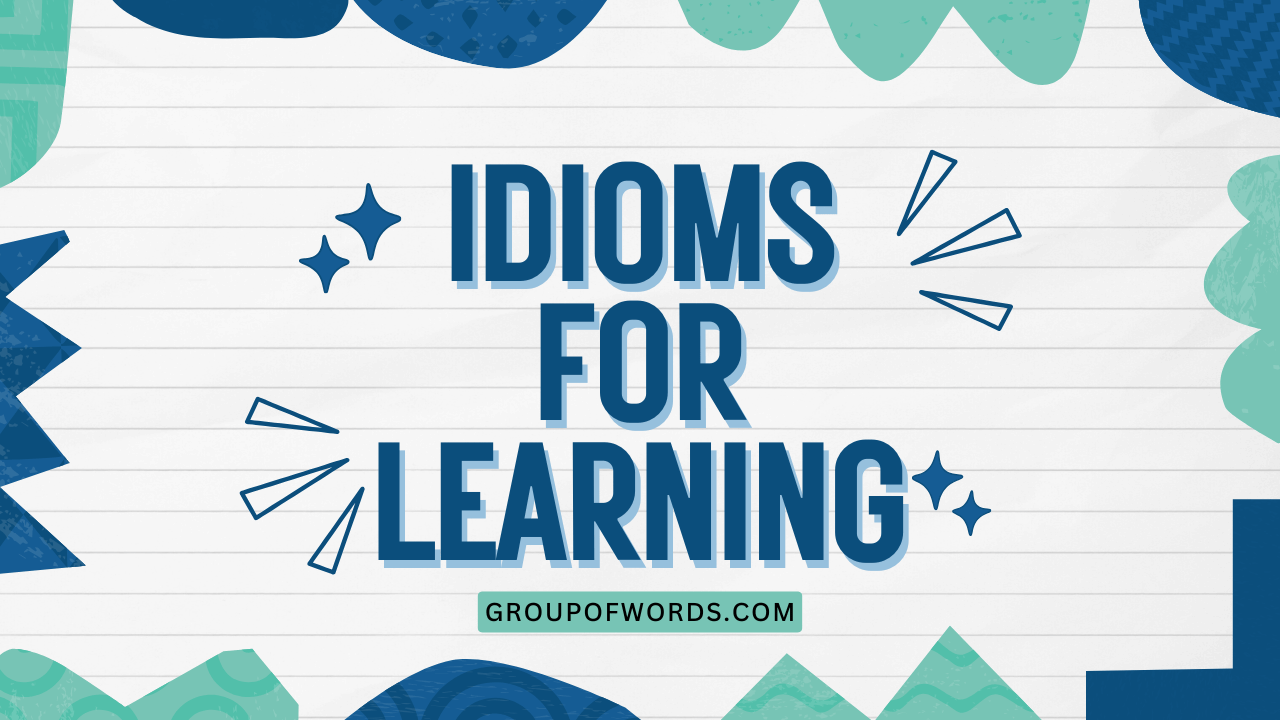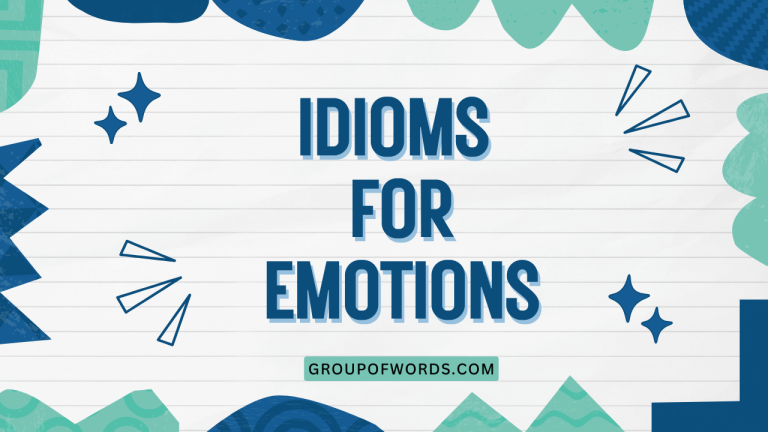Idioms for Learning: Mastering English Through Figurative Language
Idioms are a crucial part of the English language, adding color, depth, and nuance to everyday conversations and written texts. Understanding idioms is essential for anyone looking to achieve fluency and a deeper comprehension of English.
This article breaks down the concept of idioms related to learning, providing definitions, examples, usage rules, and practice exercises to help you master this challenging aspect of English. Whether you are a beginner or an advanced learner, this comprehensive guide will equip you with the knowledge and skills to confidently use and interpret idioms in various contexts.
Table of Contents
- Introduction
- Definition of Idioms for Learning
- Structural Breakdown of Idioms
- Types of Idioms Related to Learning
- Examples of Idioms for Learning
- Usage Rules for Idioms
- Common Mistakes with Idioms
- Practice Exercises
- Advanced Topics in Idiom Usage
- Frequently Asked Questions
- Conclusion
Introduction
Idioms are expressions whose meanings cannot be understood from the literal definitions of the individual words. They are figurative phrases that have evolved over time and become ingrained in the English language.
For English language learners, mastering idioms is a significant step towards achieving native-like fluency. This article focuses specifically on idioms related to the theme of “learning,” exploring their meanings, usage, and common pitfalls.
By studying these idioms, you’ll not only expand your vocabulary but also gain a deeper understanding of how native speakers express themselves.
Understanding idioms is like unlocking a secret code to the English language. It allows you to grasp the subtle nuances and cultural references that are often missed by those who only understand the literal meaning of words.
This guide will provide you with the tools and knowledge necessary to confidently navigate the world of English idioms, enhancing your communication skills and enriching your overall language learning experience. So, let’s dive in and explore the fascinating world of idioms for learning!
Definition of Idioms for Learning
An idiom is a phrase or expression whose meaning is different from the literal meaning of the words it contains. Idioms are a type of figurative language, where words are used in a non-literal sense to create a specific effect.
Idioms related to “learning” are phrases that describe aspects of education, understanding, knowledge acquisition, and intellectual development. These idioms often use metaphors, similes, and other figures of speech to convey complex ideas in a concise and memorable way.
Idioms function as a form of linguistic shorthand, allowing speakers to express complex ideas or emotions quickly and efficiently. They are often rooted in cultural contexts, historical events, or common experiences, which contributes to their unique and sometimes opaque meanings.
When we talk about idioms for learning, we are referring to expressions that specifically describe the process of gaining knowledge, understanding concepts, or developing skills. These idioms can refer to the challenges, successes, and various stages of the learning journey.
Classification of Idioms
Idioms can be classified in various ways, including by their structure, meaning, or origin. For the purpose of this article, we will classify idioms related to learning based on the specific aspect of learning they describe:
- Effort and Dedication: Idioms that describe the amount of effort required to learn something.
- Understanding and Comprehension: Idioms that refer to grasping a concept or idea.
- Progress and Achievement: Idioms that describe the advancement in one’s learning.
- Challenges and Difficulties: Idioms that highlight the obstacles faced during learning.
- Methods and Approaches: Idioms that describe different ways of learning.
Function of Idioms
The primary function of idioms is to add color and expressiveness to language. They allow speakers and writers to convey complex ideas in a concise and memorable way.
In the context of learning, idioms can be used to:
- Emphasize a point or idea.
- Add humor or irony to a situation.
- Provide a more vivid or relatable description.
- Connect with the audience on a cultural level.
Contexts of Idioms
Idioms are used in a wide range of contexts, including:
- Everyday Conversations: Idioms are commonly used in informal settings to express opinions, share experiences, and make observations.
- Academic Writing: While less common in formal academic writing, idioms can be used sparingly to add emphasis or clarity.
- Literature and Creative Writing: Idioms are frequently used in novels, poems, and other forms of creative writing to create vivid imagery and enhance the reader’s experience.
- Business Communication: Idioms are often used in business meetings, presentations, and emails to convey ideas in a concise and engaging way.
Structural Breakdown of Idioms
Idioms, while seemingly simple phrases, can have complex structures. Understanding these structures helps in recognizing and interpreting idioms correctly.
They can be phrases, clauses, or even sentences, and their grammatical structure often deviates from standard English rules when interpreted literally.
Phrasal Idioms
These are the most common type of idiom, consisting of a group of words that function as a single unit of meaning. They often involve verbs and prepositions or adverbs.
For example, “hit the books” is a phrasal idiom that means “to study hard.” The literal meaning of “hit” and “books” has nothing to do with studying, but together, they form a distinct idiomatic meaning.
Clausal Idioms
These are idioms that take the form of a clause, often expressing a complete thought or idea. They may contain a subject and a verb, but their overall meaning is figurative.
An example is “the more you learn, the more you know,” which is a clausal idiom emphasizing the direct relationship between learning and knowledge acquisition. While grammatically a complete sentence, its function is to express a general truth about learning.
Binomial Idioms
These idioms consist of two words joined by a conjunction, usually “and.” The order of the words is usually fixed, and changing the order can alter or negate the idiom’s meaning.
For instance, “trial and error” is a binomial idiom that refers to learning by experimenting and making mistakes. The phrase “error and trial” doesn’t have the same idiomatic meaning.
Trinomial Idioms
Similar to binomial idioms, trinomial idioms consist of three words or phrases, often joined by conjunctions. Like binomials, the order is usually fixed.
An example is “read, write, and learn,” which encapsulates the fundamental skills involved in education. Changing the order would diminish the idiomatic impact.
Types of Idioms Related to Learning
Idioms related to learning can be categorized based on the specific aspects of the learning process they describe. Here are some common types:
Effort and Dedication
These idioms describe the amount of effort and dedication required to learn something. They often emphasize the hard work and perseverance needed to succeed in one’s studies.
Examples include: “hit the books,” “burn the midnight oil,” and “go the extra mile.” These phrases highlight the commitment and diligence necessary for effective learning.
Understanding and Comprehension
These idioms refer to the act of grasping a concept or idea. They often describe the moment of realization or the ability to see something clearly.
Examples include: “see the light,” “get the hang of it,” and “wrap your head around something.” These idioms capture the process of understanding and making sense of new information.
Progress and Achievement
These idioms describe the advancement in one’s learning and the successful completion of a task or goal. They often celebrate the positive outcomes of hard work and dedication.
Examples include: “pass with flying colors,” “ace a test,” and “make the grade.” These idioms highlight the sense of accomplishment and success in academic endeavors.
Challenges and Difficulties
These idioms highlight the obstacles and challenges faced during the learning process. They often describe the struggles and setbacks that learners encounter.
Examples include: “hit a wall,” “draw a blank,” and “learn the hard way.” These idioms acknowledge the difficulties and frustrations that are a natural part of learning.
Methods and Approaches
These idioms describe different ways of learning and studying. They often refer to specific techniques or strategies that can be used to improve one’s understanding.
Examples include: “learn by heart,” “rote learning,” and “teach an old dog new tricks.” These idioms reflect different approaches to acquiring knowledge and skills.
Examples of Idioms for Learning
Here are several examples of idioms related to learning, categorized by their type. Each table provides the idiom, its meaning, and example sentences to illustrate its usage.
Effort and Dedication Idioms
The following table illustrates idioms related to the effort and dedication required for learning. These idioms often emphasize hard work and perseverance.
| Idiom | Meaning | Example Sentence |
|---|---|---|
| Hit the books | To study hard | I need to hit the books tonight if I want to pass my exam. |
| Burn the midnight oil | To work or study late into the night | She had to burn the midnight oil to finish her thesis on time. |
| Go the extra mile | To do more than what is expected | He always goes the extra mile in his studies to achieve top grades. |
| Keep your nose to the grindstone | To work very hard and diligently | If you want to succeed in this course, you’ll need to keep your nose to the grindstone. |
| Sweat blood | To work extremely hard and with great effort | I sweated blood over that project, but it was worth it in the end. |
| Put your shoulder to the wheel | To make a determined effort | We all need to put our shoulder to the wheel if we want to complete this assignment on time. |
| Leave no stone unturned | To try every possible course of action in order to find or achieve something | The researchers left no stone unturned in their quest to find a cure for the disease. |
| Plug away at | To work steadily and persistently at something | He plugged away at his studies, even when he found them difficult. |
| Be a glutton for punishment | To enjoy doing something difficult or unpleasant | She must be a glutton for punishment, signing up for so many challenging courses. |
| Work your fingers to the bone | To work extremely hard | He worked his fingers to the bone to earn enough money for his education. |
| Go all out | To make a maximum effort | I’m going to go all out on this final exam to get an A in the class. |
| Pull out all the stops | To do everything possible to succeed | They pulled out all the stops to ensure the project was a success. |
| Give it your all | To put in maximum effort | You have to give it your all if you want to excel in your studies. |
| Bend over backwards | To try very hard to help someone | The teacher bent over backwards to help the struggling student. |
| Move heaven and earth | To do everything possible to achieve something | I’ll move heaven and earth to make sure you get the best education. |
| Leave no avenue unexplored | To investigate every possibility | The detective left no avenue unexplored in his search for the truth. |
| Paddle your own canoe | To be independent and take responsibility for your actions | In college, you have to paddle your own canoe and manage your time effectively. |
| Roll up your sleeves | To prepare to work hard | Let’s roll up our sleeves and get this project finished. |
| Put your heart and soul into | To dedicate oneself entirely to something | She put her heart and soul into her studies and achieved excellent results. |
| Stay the course | To persevere and continue despite difficulties | Even when things get tough, it’s important to stay the course and keep studying. |
| Go the distance | To persevere to the end | With hard work and determination, you can go the distance and achieve your goals. |
| Grind away | To work hard and persistently, often at something tedious | He had to grind away at the data analysis for weeks to complete the research. |
| Take pains | To make a great effort | She took pains to ensure her presentation was perfect. |
Understanding and Comprehension Idioms
This table highlights idioms that describe the process of understanding and comprehension. These idioms often refer to gaining insight or clarity.
| Idiom | Meaning | Example Sentence |
|---|---|---|
| See the light | To understand something after a period of confusion | After the teacher explained it again, I finally saw the light. |
| Get the hang of it | To learn how to do something | It took me a while, but I finally got the hang of coding. |
| Wrap your head around something | To understand something complicated | I’m trying to wrap my head around this complex math problem. |
| Click with someone | To understand each other well | She clicked with her tutor and started making progress quickly. |
| Sink in | To be fully understood or realized | It took a while for the reality of the situation to sink in. |
| Dawn on someone | To become clear to someone | It finally dawned on me that I needed to study harder. |
| Get the picture | To understand the situation | Once he explained the background, I got the picture. |
| Put two and two together | To figure something out from the available clues | I put two and two together and realized he was the one who stole the exam answers. |
| Grasp the nettle | To tackle a difficult task with determination | You have to grasp the nettle and face your fears to succeed. |
| Get your head around | To understand something complicated | I can’t seem to get my head around this new software. |
| Get it | To understand | Oh, I get it now! Thanks for explaining. |
| Make sense of | To understand something confusing | I’m trying to make sense of this complicated theory. |
| Figure out | To solve or understand something | I need to figure out how to use this new tool. |
| Get to the bottom of | To discover the truth about something | We need to get to the bottom of why the students are failing. |
| Have a handle on | To have control or understanding of something | I think I finally have a handle on this project. |
| Be on the same wavelength | To understand each other | They’re always on the same wavelength when it comes to problem-solving. |
| See eye to eye | To agree with someone | We don’t always see eye to eye, but we respect each other’s opinions. |
| Connect the dots | To understand how different pieces of information relate | He was able to connect the dots and solve the mystery. |
| Piece together | To assemble something from different parts | The detective had to piece together the evidence to solve the case. |
| Learn the ropes | To learn the basics of a job or task | It takes time to learn the ropes when you start a new job. |
| Get the drift | To understand the general meaning | I get the drift of what you’re saying, but I need more details. |
| Grok | To understand something intuitively | Once you grok the underlying principles, the rest is easy. |
Progress and Achievement Idioms
This table presents idioms that describe progress and achievement in learning. These idioms often celebrate success and positive outcomes.
| Idiom | Meaning | Example Sentence |
|---|---|---|
| Pass with flying colors | To pass easily and with a high score | She passed the exam with flying colors. |
| Ace a test | To get a very high score on a test | He aced the final exam. |
| Make the grade | To reach the required standard | She worked hard and finally made the grade. |
| Top of the class | To be the best student in the class | He graduated top of the class. |
| Come a long way | To make significant progress | She’s come a long way since she started learning English. |
| Turn over a new leaf | To start behaving in a better way | After failing the first exam, he decided to turn over a new leaf and study harder. |
| Hit the nail on the head | To accurately identify the main issue | You hit the nail on the head when you said motivation is key. |
| Go places | To be successful | That young entrepreneur is definitely going places. |
| Master the art of | To become very skilled at something | She has mastered the art of public speaking. |
| Reach for the stars | To aim high | Always reach for the stars, even if you don’t quite get there. |
| Climb the ladder | To advance in a career or field | He quickly climbed the ladder in the company. |
| Go from strength to strength | To become increasingly successful | The company has gone from strength to strength in recent years. |
| Come into your own | To become confident and successful | She really came into her own during her final year of college. |
| Breakthrough | A significant advance or discovery | The scientists achieved a major breakthrough in cancer research. |
| Get ahead of the curve | To be more advanced than others | By starting early, he got ahead of the curve in his studies. |
| Make strides | To make good progress | The team has been making strides in their project. |
| On the right track | Moving in the correct direction | You’re on the right track with your research. |
| Raise the bar | To set higher standards | The new regulations will raise the bar for safety. |
| Set the standard | To establish a high level of performance | Their innovative approach set the standard for the industry. |
| Shine | To excel | She really shone during the presentation. |
Challenges and Difficulties Idioms
The following table provides idioms that describe the challenges and difficulties encountered during learning. These idioms often acknowledge setbacks and struggles.
| Idiom | Meaning | Example Sentence |
|---|---|---|
| Hit a wall | To reach a point where you can no longer make progress | I’ve hit a wall in my research and need to find a new approach. |
| Draw a blank | To be unable to remember something | I drew a blank when the teacher asked me the question. |
| Learn the hard way | To learn something through a difficult or unpleasant experience | He learned the hard way that procrastination is not a good strategy. |
| Barking up the wrong tree | To be pursuing a mistaken or misguided course of action | If you think he’s the one who stole the money, you’re barking up the wrong tree. |
| Come up against a brick wall | To encounter an insurmountable obstacle | The negotiations came up against a brick wall. |
| Fall flat on your face | To fail completely | If you don’t prepare properly, you might fall flat on your face. |
| Go down in flames | To fail spectacularly | The project went down in flames due to poor planning. |
| Lose your train of thought | To forget what you were saying | I lost my train of thought when the phone rang. |
| Off the top of your head | Without careful thought or preparation | I can’t remember the answer off the top of my head. |
| Out of your depth | In a situation that is too difficult for you to handle | I felt out of my depth in the advanced math class. |
| Bite off more than you can chew | To take on more than you can handle | He bit off more than he could chew when he signed up for three difficult courses. |
| Go against the grain | To act or think in opposition to the prevailing norms | Her ideas went against the grain, but they were ultimately successful. |
| Have your work cut out for you | To have a difficult task ahead | You’ll have your work cut out for you if you want to pass this exam. |
| Jump through hoops | To go through a series of difficult or unnecessary steps | The students had to jump through hoops to get their applications approved. |
| Keep your head above water | To manage to survive in a difficult situation | He’s just trying to keep his head above water while studying and working. |
| Miss the boat | To miss an opportunity | If you don’t apply soon, you’ll miss the boat. |
| Skating on thin ice | To be in a risky situation | He’s skating on thin ice after missing so many classes. |
| Stumble | To make a mistake | She stumbled during her presentation, but she recovered quickly. |
| Get bogged down | To become overwhelmed by details | The project got bogged down in technical issues. |
| Get nowhere | To make no progress | We’re getting nowhere with this approach. |
Methods and Approaches Idioms
This table lists idioms that describe different methods and approaches to learning.
| Idiom | Meaning | Example Sentence |
|---|---|---|
| Learn by heart | To memorize something | I had to learn the poem by heart for the exam. |
| Rote learning | Learning through repetition | Rote learning can be effective for memorizing facts, but it doesn’t always lead to understanding. |
| Teach an old dog new tricks | To teach someone new skills, especially someone who is older or set in their ways | It’s difficult to teach an old dog new tricks, but it’s not impossible. |
| Pick up something | To learn something quickly and easily | She picked up Spanish very quickly. |
| Brush up on | To review or improve your knowledge of something | I need to brush up on my math skills before the exam. |
| Bone up on | To study hard in preparation for something | I need to bone up on my history before the test. |
| Major in | To specialize in a particular subject at university | She majored in biology. |
| Minor in | To study a secondary subject at university | He minored in creative writing. |
| Take a course | To enroll in and attend a series of lessons | I’m taking a course in web design. |
| Go back to school | To return to education after a break | He decided to go back to school to get his master’s degree. |
| Learn from the ground up | To learn something from the beginning | He had to learn the business from the ground up. |
| Learn on the job | To learn skills while working | Most of my skills I learned on the job. |
| Study under | To learn from a particular teacher or mentor | He studied under a famous professor. |
| By trial and error | Learning by experimenting and making mistakes | He learned to code by trial and error. |
| Hands-on learning | Learning by doing | The course emphasized hands-on learning. |
Usage Rules for Idioms
Using idioms correctly requires understanding their specific meanings and the contexts in which they are appropriate. While idioms add richness and color to the English language, they can also be tricky to master.
Here are some important usage rules to keep in mind:
Contextual Appropriateness
Idioms are not always appropriate for all situations. In formal writing or professional settings, it’s often best to use more direct and literal language.
However, in casual conversations or creative writing, idioms can add a touch of personality and make your communication more engaging. Be mindful of your audience and the overall tone of the communication when deciding whether to use an idiom.
Literal vs. Figurative Meaning
Remember that idioms have a figurative meaning that is different from the literal meaning of the individual words. It’s important to understand the intended meaning of the idiom and use it in a way that makes sense within the context of the sentence.
Grammatical Structure
Pay attention to the grammatical structure of idioms. Some idioms are fixed expressions and cannot be changed, while others allow for some flexibility.
Make sure to use the correct form of the idiom to avoid sounding awkward or incorrect.
Cultural Sensitivity
Be aware that some idioms may be culturally specific and may not be understood by everyone. When communicating with people from different cultural backgrounds, it’s best to avoid using idioms that may be unfamiliar or offensive.
Overuse
While idioms can enhance your communication, overuse can make your writing or speech sound forced or unnatural. Use idioms sparingly and only when they add value to your message.
Common Mistakes with Idioms
One of the biggest challenges for English language learners is avoiding common mistakes when using idioms. Here are some frequent errors and how to correct them:
Literal Interpretation
Incorrect: “I’m going to hit the books, literally.”
Correct: “I’m going to hit the books tonight.”
The mistake here is taking the idiom “hit the books” literally. The correct usage involves understanding that it means “to study hard.”
Incorrect Word Order
Incorrect: “He learned the way hard.”
Correct: “He learned the hard way.”
Idioms often have a fixed word order. Changing the order can alter or negate the meaning.
In this case, “learn the hard way” is the correct idiom.
Mixing Idioms
Incorrect: “Let’s burn the candle at both ends and hit the books.”
Correct: “Let’s burn the midnight oil and hit the books.”
Mixing idioms can create nonsensical phrases. “Burn the candle at both ends” and “burn the midnight oil” are similar but distinct idioms.
Sticking to the correct wording is crucial.
Wrong Preposition
Incorrect: “I need to brush up my skills.”
Correct: “I need to brush up on my skills.”
Many idioms rely on specific prepositions. Using the wrong preposition can change the meaning or make the idiom grammatically incorrect.
Overuse of Idioms
Incorrect: “I’m going to hit the books because I need to make the grade. I’m hoping to ace the test and pass with flying colors. It’s going to be tough, but I’m ready to burn the midnight oil.”
Correct: “I’m going to study hard because I want to do well on the test. It’s going to be tough, but I’m ready to put in the extra effort.”
Overusing idioms can make your language sound unnatural and forced. It’s better to use idioms sparingly and choose more direct language when appropriate.
Practice Exercises
Test your understanding of idioms with these practice exercises. Each exercise includes multiple-choice questions and fill-in-the-blank sentences.
Answers are provided at the end of each exercise.
Exercise 1: Multiple Choice
Choose the correct meaning of the idiom in each sentence.
- He had to burn the midnight oil to finish his project. What does “burn the midnight oil” mean?
- To work or study late into the night
-
To light candles at midnight
- To waste time on unimportant tasks
- She finally saw the light and understood the concept. What does “see the light” mean?
- To experience a sudden illumination
- To understand something after a period of confusion
- To ignore the obvious
- He decided to hit the books after failing the quiz. What does “hit the books” mean?
- To physically strike books
- To avoid studying
- To study hard
- After much practice, she got the hang of coding. What does “get the hang of” mean?
- To understand how to hang something
- To become frustrated with a task
- To learn how to do something
- They passed with flying colors. What does “passed with flying colors” mean?
- To fail spectacularly
- To pass easily and with a high score
- To barely pass a test
Answers:
- a
- b
- c
- c
- b
Exercise 2: Fill in the Blank
Complete the following sentences with the correct idiom from the list below.
Idiom List:
- hit a wall
- draw a blank
- make the grade
- get the picture
- learn by heart
- After hours of studying, I started to ________ and couldn’t remember anything.
- He needed to work harder if he wanted to ________ in the class.
- I tried to memorize the poem, so I had to ________.
- During the project, we ________ and couldn’t find a solution.
- Once the teacher explained the situation, I ________.
Answers:
- draw a blank
- make the grade
- learn by heart
- hit a wall
- got the picture
Exercise 3: True or False
Determine if the following sentences use the idiom correctly. Mark True or False.
- True or False: She burned the midnight oil by going to bed early.
- True or False: If you want to ace the test, you need to hit the books.
- True or False: He saw the light and decided to ignore the problem.
- True or False: They made the grade by not studying at all.
- True or False: After practicing, she got the hang of doing the backstroke.
Answers:
- False
- True
- False
- False
- True
Advanced Topics in Idiom Usage
Once you have a solid grasp of basic idioms, you can delve into more advanced topics to refine your understanding and usage. These include understanding the origins of idioms, recognizing subtle variations, and using idioms creatively.
Origins of Idioms
Many idioms have interesting historical or cultural origins. Understanding these origins can provide deeper insight into their meanings and usage.
For example, the idiom “break a leg,” used to wish someone good luck, is believed to have originated in the theater. Knowing this background can add context and appreciation when using the idiom.
Variations of Idioms
Some idioms have slight variations that are still considered correct. These variations can add nuance or emphasis to the meaning.
For example, “get the hang of it” can also be expressed as “get the knack of it.” Recognizing these variations can help you understand and use idioms more flexibly.
Creative Idiom Usage
While it’s important to use idioms correctly, there’s also room for creativity in their application. Skilled writers and speakers sometimes play with idioms to create humor, irony, or emphasis.
However, this requires a deep understanding of the idiom’s meaning and context to avoid confusion or misinterpretation.
Frequently Asked Questions
Why are idioms so difficult to learn?
Idioms are difficult to learn because their meanings are not literal and often require cultural or historical context to understand. Additionally, there are many idioms in the English language, and memorizing them all can be challenging.
How can I improve my understanding of idioms?
To improve your understanding of idioms, focus on learning them in context. Read widely, listen to native speakers, and pay attention to how idioms are used in different situations.
Practice using idioms in your own writing and speaking, and don’t be afraid to ask for feedback.
Are idioms used in formal writing?
Idioms are generally more common in informal writing and speech. In formal writing, it’s often best to use more direct and literal language to avoid ambiguity.
However, idioms can be used sparingly in formal writing to add emphasis or clarity, as long as they are appropriate for the audience and context.
What is the best way to memorize idioms?
The best way to memorize idioms is to use them actively. Write sentences using the idioms, create flashcards, or practice using them in conversations.
Repetition and context are key to retaining the meanings of idioms.
Are there resources available to help me learn idioms?
Yes, there are many resources available to help you learn idioms. These include idiom dictionaries, online quizzes, language learning apps, and textbooks.
Additionally, watching English-language movies and TV shows can expose you to idioms in a natural context.
Conclusion
Mastering idioms related to learning is a valuable step towards achieving fluency and a deeper understanding of the English language. By understanding the definition, structure, types, and usage rules of idioms, you can enhance your communication skills and express yourself more effectively.
Remember to practice regularly, pay attention to context, and be mindful of common mistakes. With dedication and consistent effort, you can confidently navigate the world of English idioms and unlock a new level of linguistic proficiency.
Keep hitting the books and burning the midnight oil, and you’ll be sure to make the grade!






